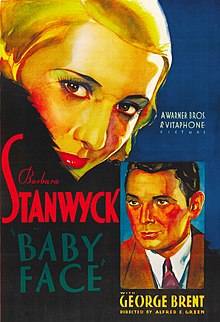Our website is made possible by displaying online advertisements to our visitors.
Please consider supporting us by disabling your ad blocker.
Baby Face (film)
| Baby Face | |
|---|---|
 theatrical release poster | |
| Directed by | Alfred E. Green |
| Screenplay by | Gene Markey Kathryn Scola |
| Story by | "Mark Canfield" (Darryl F. Zanuck)[1] |
| Produced by | William LeBaron Raymond Griffith |
| Starring | Barbara Stanwyck George Brent |
| Cinematography | James Van Trees |
| Edited by | Howard Bretherton |
Production company | |
| Distributed by | Warner Bros. |
Release date |
|
Running time | 76 minutes 71 minutes (censored version)[1] |
| Country | United States |
| Language | English |
| Budget | $187,000[2] |
| Box office | $452,000[2] |
Baby Face is a 1933 American pre-Code-enforcement drama film directed by Alfred E. Green for Warner Bros., starring Barbara Stanwyck as Lily Powers, and featuring George Brent. Based on a story by Darryl F. Zanuck (under the pseudonym Mark Canfield), Baby Face portrays a young woman who uses sex to advance her social and financial status. Twenty-five-year-old John Wayne appears briefly as one of Powers's lovers.
Marketed with the salacious tagline "She had it and made it pay",[3] the film's open discussion of sex made it one of the most notorious films of the Pre-Code Hollywood era[4] and helped bring the era to a close as enforcement of the code became stricter beginning in 1934. Mark A. Vieira, author of Sin in Soft Focus: Pre-Code Hollywood [5] has said, "Baby Face was certainly one of the top 10 films that caused the Production Code to be enforced."[6] In 2005, Baby Face was included in the annual selection of 25 motion pictures to be added to the National Film Registry of the Library of Congress.[7][8]
- ^ a b Baby Face at the AFI Catalog of Feature Films
- ^ a b Warner Bros financial information in The William Schaefer Ledger. See Appendix 1, Historical Journal of Film, Radio and Television, (1995) 15:sup1, 1-31 p 13 DOI: 10.1080/01439689508604551
- ^ “It” refers to the idea of indefinable but powerful sex appeal publicized by Elinor Glyn in her famous—and, at the time, infamous— book, It. Glyn adapted her novel for the screen, for the 1927 film of the same name starring Clara Bow, who thereafter was known as “the It girl”.
- ^ Turan, Kenneth (2004) Never Coming to a Theater Near You: A Celebration of a Certain Kind of Movie. Public Affairs ISBN 1-58648-231-9. p.375
- ^ Cite error: The named reference
Sinwas invoked but never defined (see the help page). - ^ Cite error: The named reference
NYTimeswas invoked but never defined (see the help page). - ^ "Complete National Film Registry Listing". Library of Congress. Retrieved May 18, 2020.
- ^ Cite error: The named reference
:0was invoked but never defined (see the help page).
Previous Page Next Page


